| |

Traditions, folklore, history and more. If it's Irish, it's here. Or will be!
"People will not look forward to posterity who never look backward to their ancestors."
-Edmund Burke




Quotes
Library: Books, Movies, Music
Prints & Photos
Poetry
Jokes


Shops Ireland
Bunús na Gaeilge
(Basic Irish)
Circle of Prayer
Blessings
Did You Know?
Himself/Herself
Write to Us
Readers Write..
Links/Link to Us
Advertise with us
Awards & Testimonials
Submissions Guide

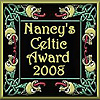
|
|
|
Inishmurray: Land of Gale, Stone and Fire
by Joe McGowan
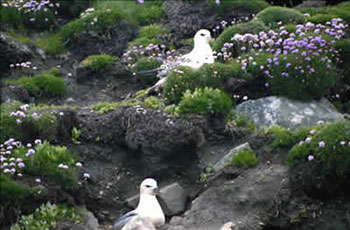
Sceilg Michael, Inisheer, Inishmaan, Tory: these are all enchanted places that call to mind visions of offshore islands shrouded in romance and mystery, repositories of culture and customs lost and gone forever on the more accessible mainland.
The remote and mystical Inishmurray Island four miles from the coast of Sligo rivals all of these for its state of preservation as an early Christian site, for its wild scenery and as a wildlife sanctuary. St Molaise founded a Christian Monastery here in the 6th century, the remains of which are remarkably intact to this day.
Battle of the Books
Drumcliffe on the mainland was founded by St. Colmcille in 574 AD. St. Molaise of Inishmurray was confessor to St. Colmcille and it was to him this holy man went in great remorse after the Battle of the Books at Cooldruman in north Sligo. The battle came about when Colmcille copied a book while a guest of St. Finian. St. Finian requested that the copy be returned to him and Colmcille refused. When the problem was brought before the High King of Ireland his inspired decision of: ‘To every cow its calf and to every book its copy’, was rejected by Colmcille. In A.D. 561 the two men, mustering their armies, fought a pitched battle on the slopes of Benbulben mountain. Aided by an angel, Colmcille won the battle, thousands of men were slain, and the king had to award the copy of the psalter to Colmcille.
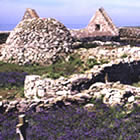 Stricken by remorse Colmcille went to Inishmurray to confess his sins to Molaise. As a result of this meeting Colmcille was banished to Iona, Scotland, in 563 A.D. His penance was to convert more people to Christ than had fallen in the Battle of Culdreimhne. Leaving Ireland he was one of a wave of Irish missionaries that colonised a barbaric Europe, bringing learning, culture and religion with them. Scots, Picts, Irish, Britons and Anglo-Saxons poured into Iona to learn at Colmcille’s feet. Stricken by remorse Colmcille went to Inishmurray to confess his sins to Molaise. As a result of this meeting Colmcille was banished to Iona, Scotland, in 563 A.D. His penance was to convert more people to Christ than had fallen in the Battle of Culdreimhne. Leaving Ireland he was one of a wave of Irish missionaries that colonised a barbaric Europe, bringing learning, culture and religion with them. Scots, Picts, Irish, Britons and Anglo-Saxons poured into Iona to learn at Colmcille’s feet.
Inishmurray island still captures the imagination. Here we may still view Molaise’s monastic settlement with it’s many curious artefacts many of which may well have their origins in pagan beliefs:
The most remarkable feature of Teac na Teine (House of the Fire) inside the main enclosure is the Leac na Teine or Stone of the Fire which is located in the centre of the floor. Tradition holds that if all the fires went out on the island a sod placed on Teac na Teine would ignite spontaneously. A visitor to the island, having heard of the magical properties of the stone, proceeded to urinate thereon so as to disprove the legend.
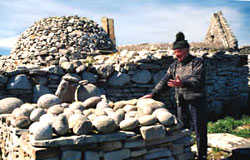 A Miraculous Occurence A Miraculous Occurence
According to an account given to W.F. Wakeman, the 19th century antiquarian, ‘a miracle was the immediate result. The fire which up to that fatal moment had been scarcely visible, at once flared up, and swiftly assumed the strength and appearance of a burning fiery furnace, its flames lapping and enveloping the wretched victim, so that he could neither struggle against them or fly, and stood melting, as it were, into nothingness, so that after a moment little remained but fragmentary bones, cracked and distorted’. Until recent times visitors to the island were shown fragments of fire-blackened human bones stored in a niche of the wall of Teach na Teine as proof that the incident actually happened.
Cursing Stones
The largest of the altars inside the compound is the Clocha Breacha commonly known as the Cursing or Speckled Stones. The power of the stones was said to have been invoked at the Clocha Breacha by the
islanders in the early 1800’s against some men connected with the coast guard who had aroused the wrath of the Inishmurray people. The men in question ‘all perished at sea a short time after’. In more recent times it was used by a woman from the mainland who travelled to the island to invoke the dark powers against Hitler. Proof indeed of the efficacy of the stones!
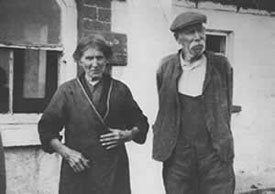 The moss covered stones of Cashel keep their counsel now, but we know that long ago they resounded, not always to the caress of prayer and hymns of praise but, on occasion, to the screams of dying men martyred by marauding Danes: The moss covered stones of Cashel keep their counsel now, but we know that long ago they resounded, not always to the caress of prayer and hymns of praise but, on occasion, to the screams of dying men martyred by marauding Danes:
‘Wasting fire and dying groan,
And priests slain on the altar stone.’
Red marks on a flagstone near the doorway of Teach Molaise (Molaise’s House) are claimed to be the blood of the last reigning Abbot murdered there by the Norsemen in 807 A.D.
Photo: Islanders Mr. & Mrs. D. Harte
Excerpted by permission of the author from “Inishmurray: Island Voices”
The men and women of Inishmurray, Co. Sligo , left their island home in 1948. The Great Blasket was evacuated five years later. The Blaskets had Tomás O’Crohan and Maurice O’Sullivan to bear witness to a lost way of life. Here, Joe Mc Gowan sets down the life and times of another ancient people. Inishmurray’s presence looms large beyond his native fields and in the tales told him by the last of the island residents.
For more on Inishmurray visit Joe’s site and click on books: "Island Voices” in “Books” section see “Inishmurray" and information on trips to Inishmurray in “Island Tours”.
http://www.sligoheritage.com.
 Author’s Bio Author’s Bio
Joe Mc Gowan is a local historian and native of Mullaghmore, Co. Sligo. Born on the family farm, he worked there in his early years until emigrating to the U.S.A. in the early ‘60s. Six months after he arrived, he was drafted into the U. S. army. Following discharge from the Army, he lived and worked in the U.S. in commercial and residential construction for many years. Marrying, he returned to Ireland with his wife and young family in the late ‘70s. The ‘Celtic Tiger’ was not yet born, scarcity of work dictated a career change, so Joe took up salmon and lobster fishing off the Sligo coast aboard his half-decker fishing boat the ‘Connaught Ranger’ and conducting tour-boat trips to Inishmurray aboard the ‘Excalibur’ with his partner Keith Clarke.
Shortly after his return to Ireland, Joe Mc Gowan, becoming keenly aware of the accelerating pace of change in the Irish countryside, decided to record the old lore before it vanished completely. Since that time he has been dedicated to preserving, visually and orally, Ireland ’s disappearing traditions and customs. Now a full-time writer his books, backed by meticulous archival research, are inspired by countless nights spent visiting the older generation and listening to their tales. His short stories, usually cameos of Irish life both past and present, feature frequently in national magazines and on radio. He is also a Heritage Specialist with the Irish National Teachers Organisation ‘Heritage in Schools Scheme’.
His publications include the classic: In the Shadow of Benbulben; Echoes of a Savage Land; Constance Markievicz; the People’s Countess; Co. Sligo Famine Book; Inishmurray Gale, Stone and Fire; Island Voices and most recently, co-authored with artist Anne Osborne: Sligo, Land of Destiny.
The days of the fireside story-tellers are gone, but their stories and lore happily live on in Joe’s books and now on his website:
http://www.sligoheritage.com.
|
|
Thu, Apr 4, 2024
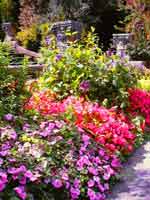 Ilnacullen, Co. Cork - an Island Garden Ilnacullen, Co. Cork - an Island Garden
Located in the sheltered harbour of Glengarriff in Bantry Bay. Ilnacullin, which means island of holly, is a small island known to horticulturists and lovers of trees and shrubs all around the world as an island garden of rare beauty.
The vivid colours of Rhododendrons and Azaleas reach their peak during May and June, whilst the hundreds of cultivars of climbing plants, herbaceous perennials and choice shrubs dominate the midsummer period from June to August.
Because of its sheltered situation and the warming oceanic influence of the Gulf Stream, the climate is favourable to the growth of ornamental plants from many parts of the world.
Even for those who aren’t particularly interested in gardens, there are many other scenic views, especially in the surrounding waters where seals frequent the rocks on the southern shore.
The cover photo on Bridget's book The Traditional Irish Wedding shows a wrought iron garden gate on Ilnaculen. I took that photo. To see it, go to the home page. It's part of the opening paragraph Failte.
—Russ
Resource: Copy and Image - Cork Guide
Click for More Culture Corner.
A book to buy, to beg, or to borrow. For here we have that rare thing, a piece of literature springing from the same natural impulse which makes a bird on a branch in April time give out a sprinkle of a song.
Irish Independent
All the customer reviews on amazon give it 5 stars. We're anxiously waiting for our copy to arrive!
Click here for 20yrs a'Growing
Note: The cover illustration is called "Launching the Curragh" by Paul Henry and the original is in the National Museum of Ireland in Dublin.
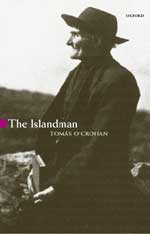
The Islandman
by Tomás O'Crohán
A valuable description of a now vanished way of life, the author's sole purpose in writing this book was in his own words, 'to set down the character of the people about me so that some record of us might live after us, for the like of us will never be again.'
Click here for The Islandman.
The Queen of Gaelic story-tellers reflects on the days of her youth, and, while here were `clouds of sorrow', helping to lift them was the friendship she found in the community, which `was like a little rose in the wilderness'.
Click here for An Old Woman's Reflections.
|
|
|
|
|




 Ilnacullen, Co. Cork - an Island Garden
Ilnacullen, Co. Cork - an Island Garden